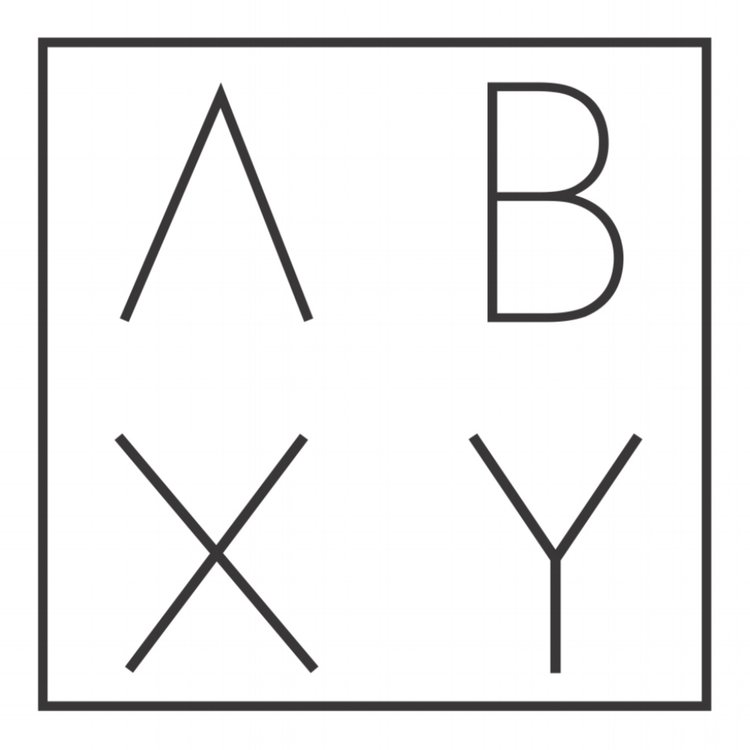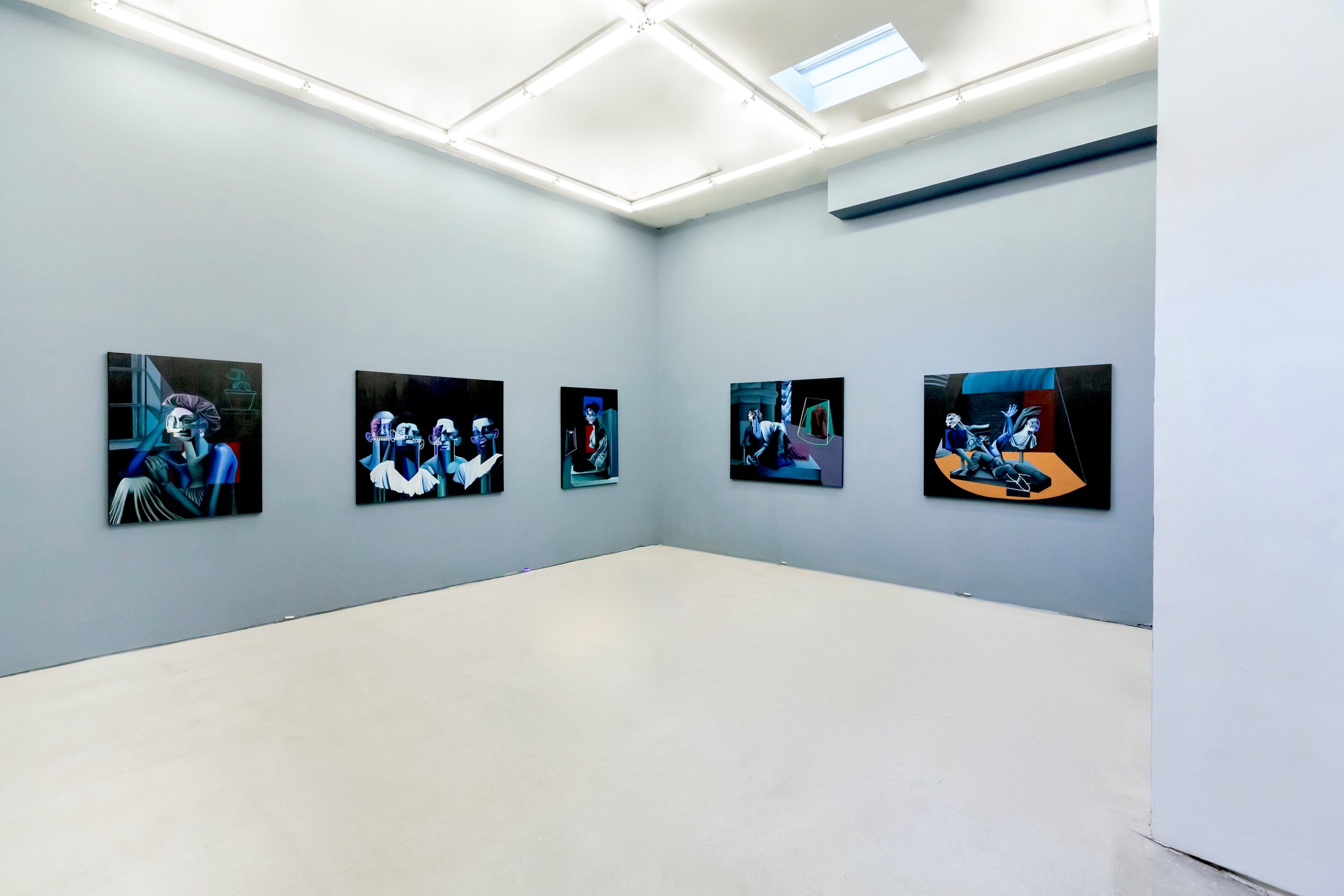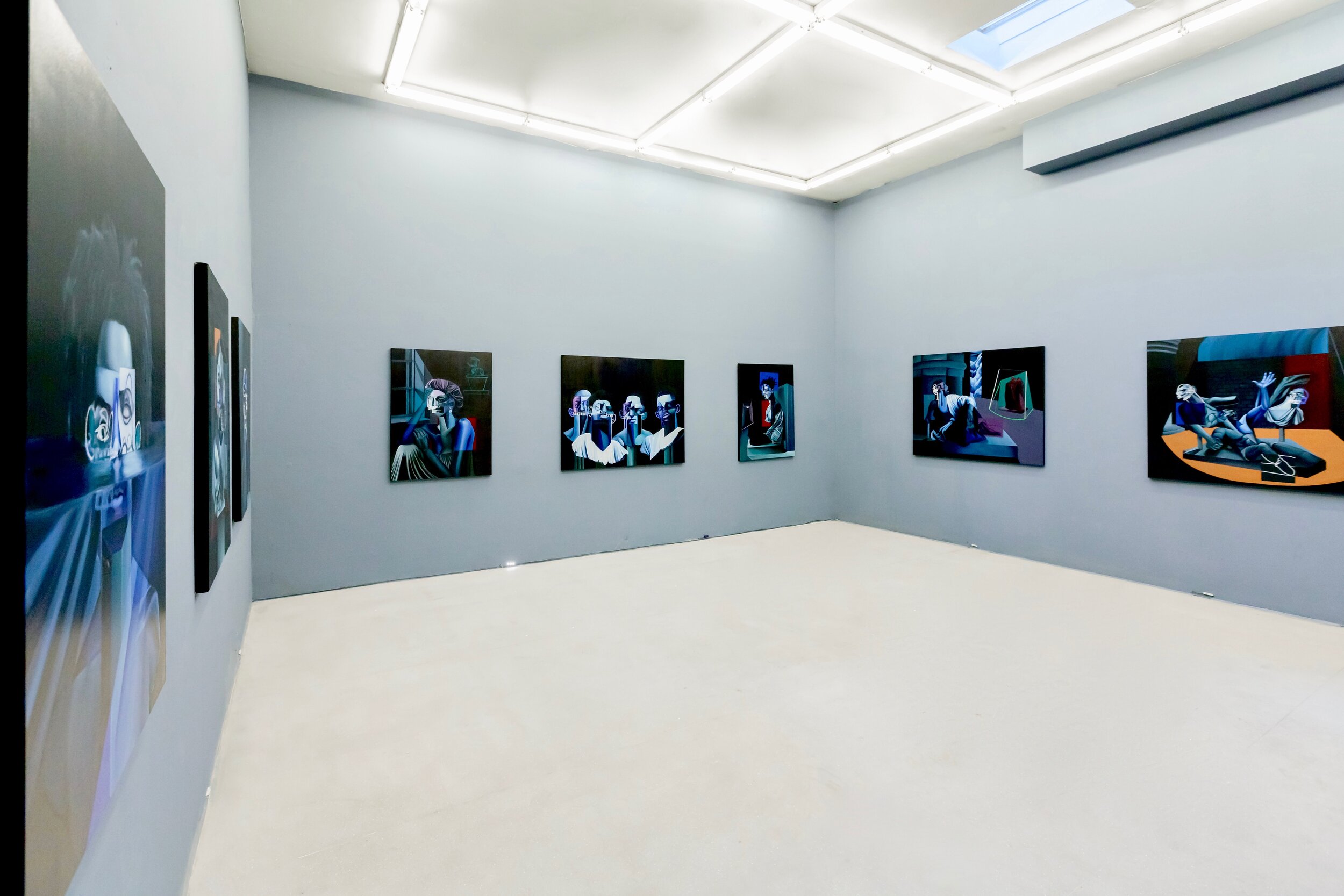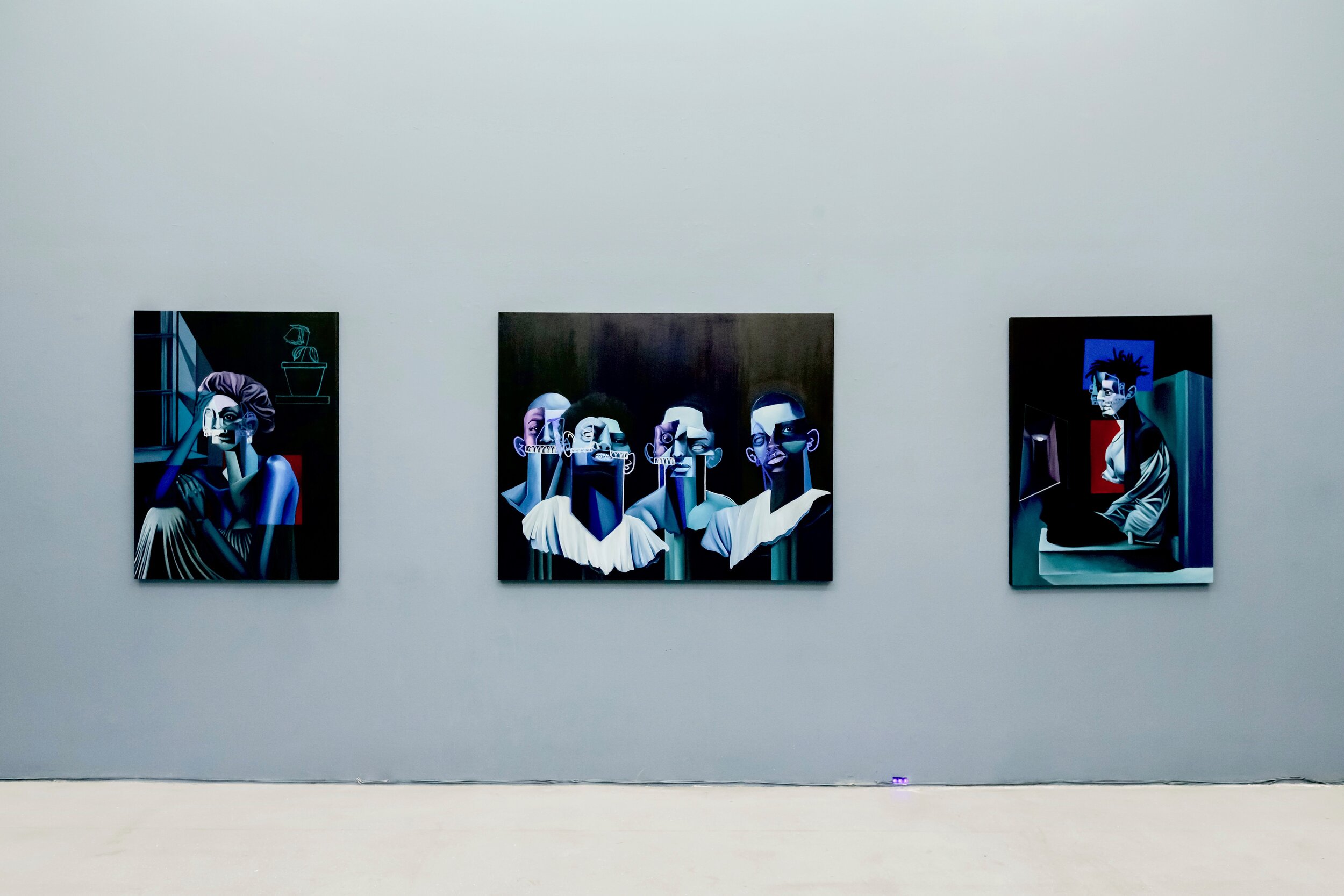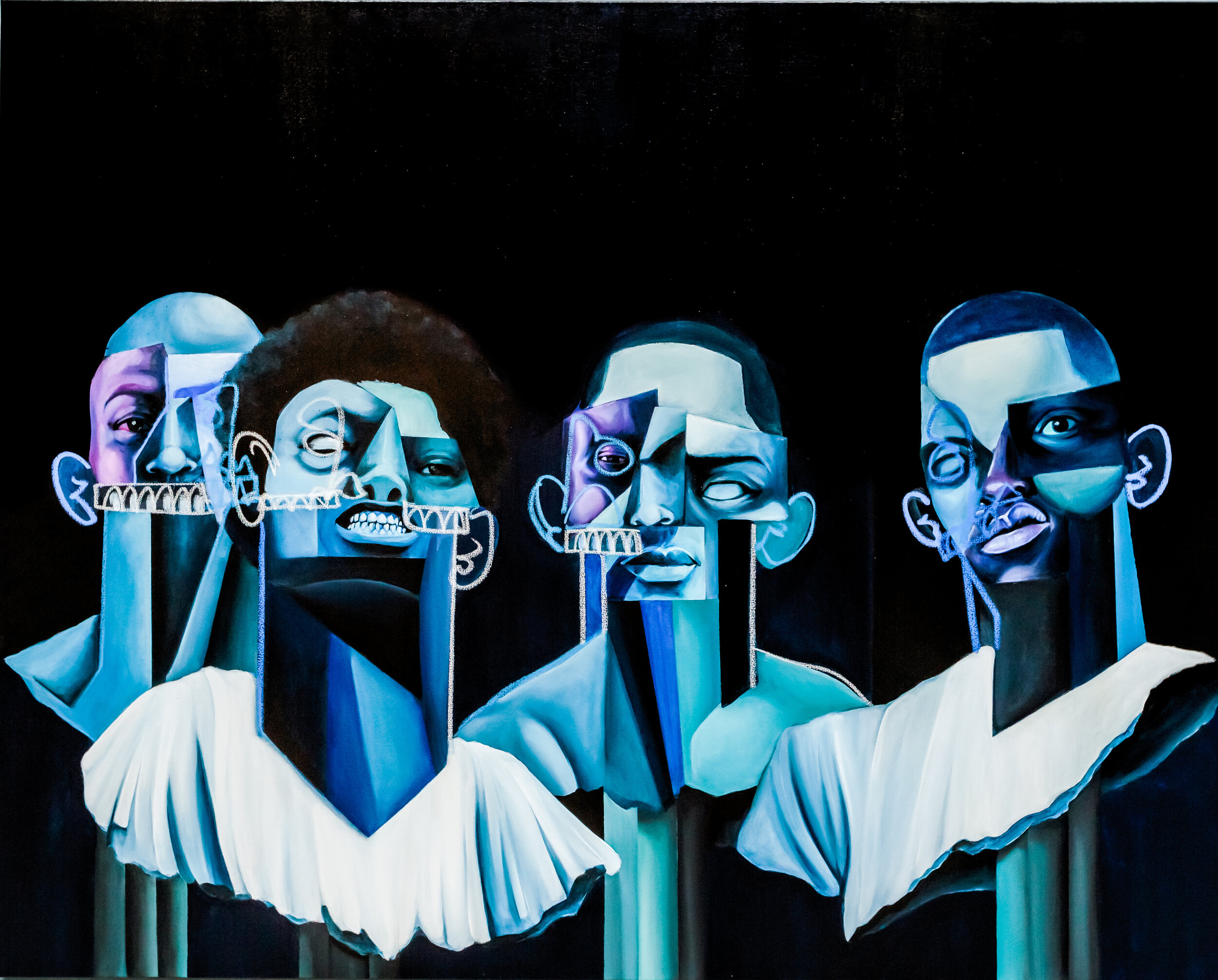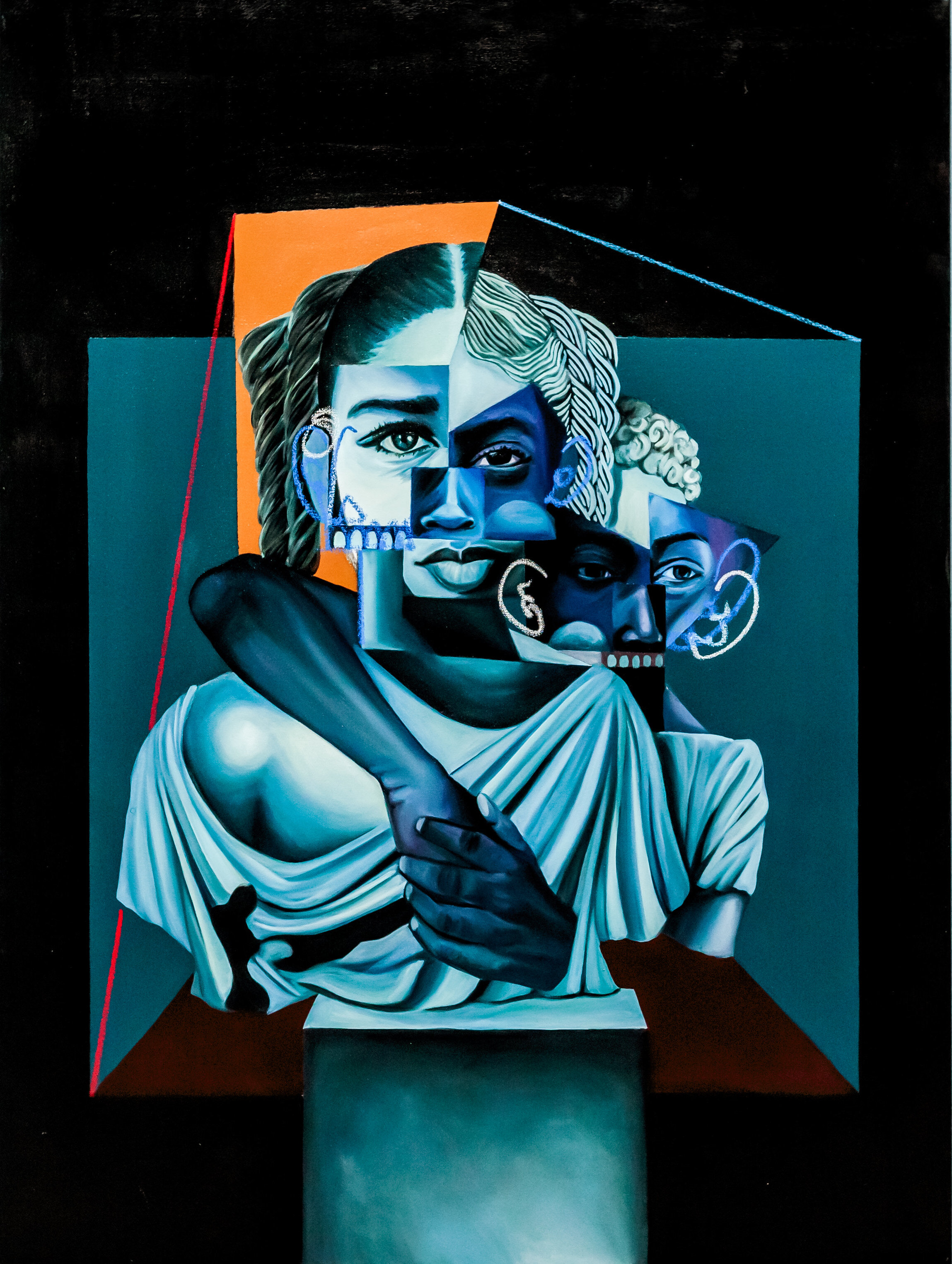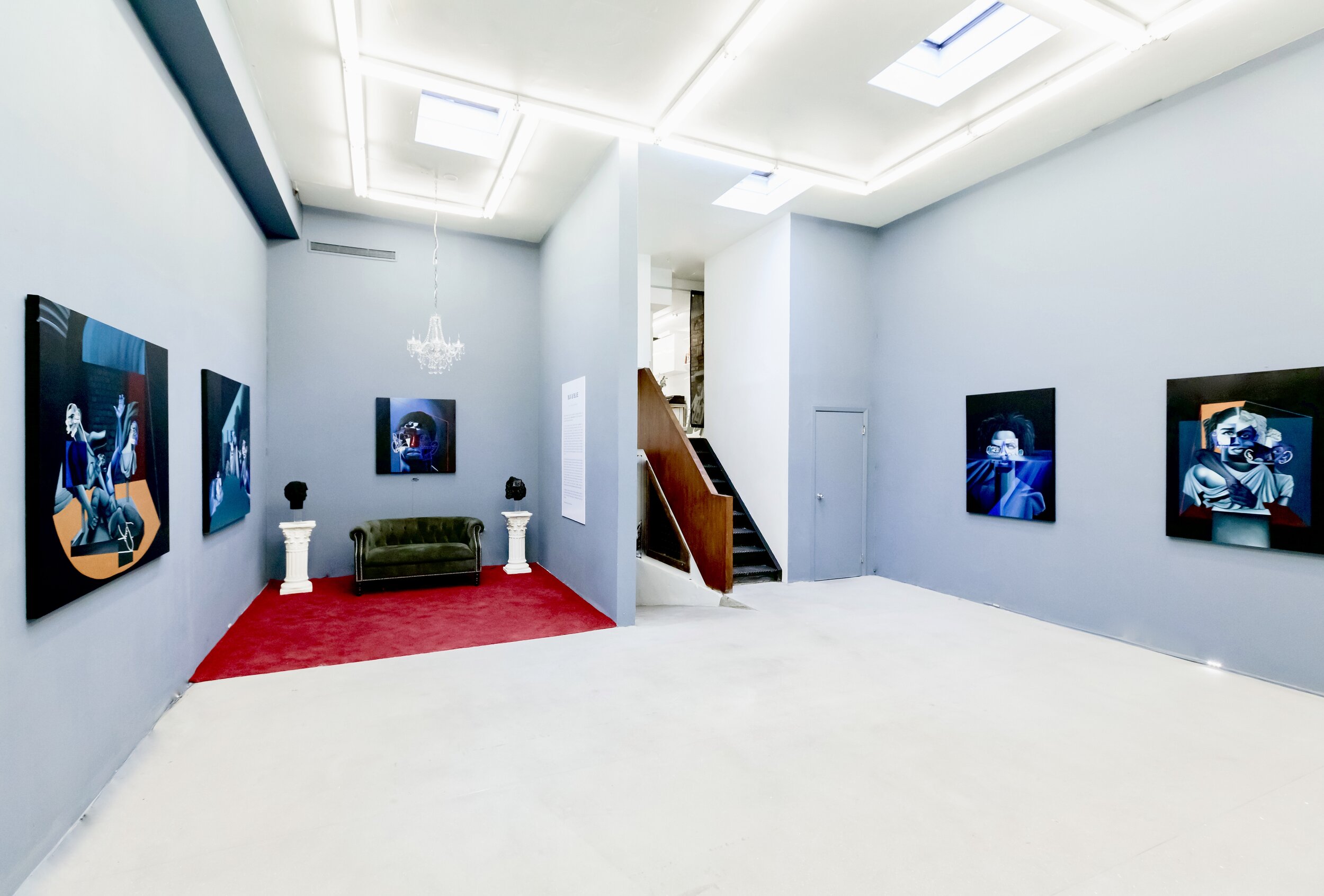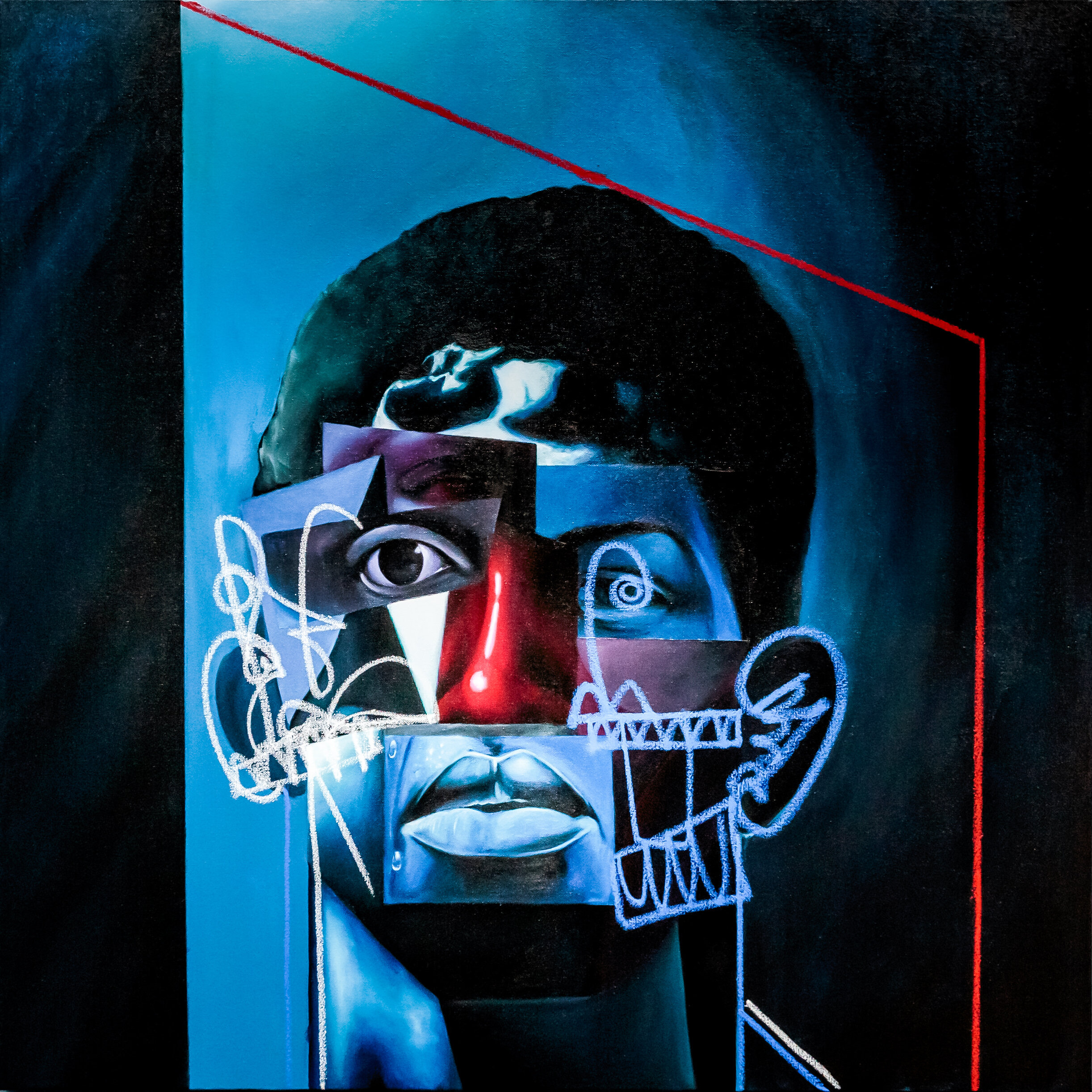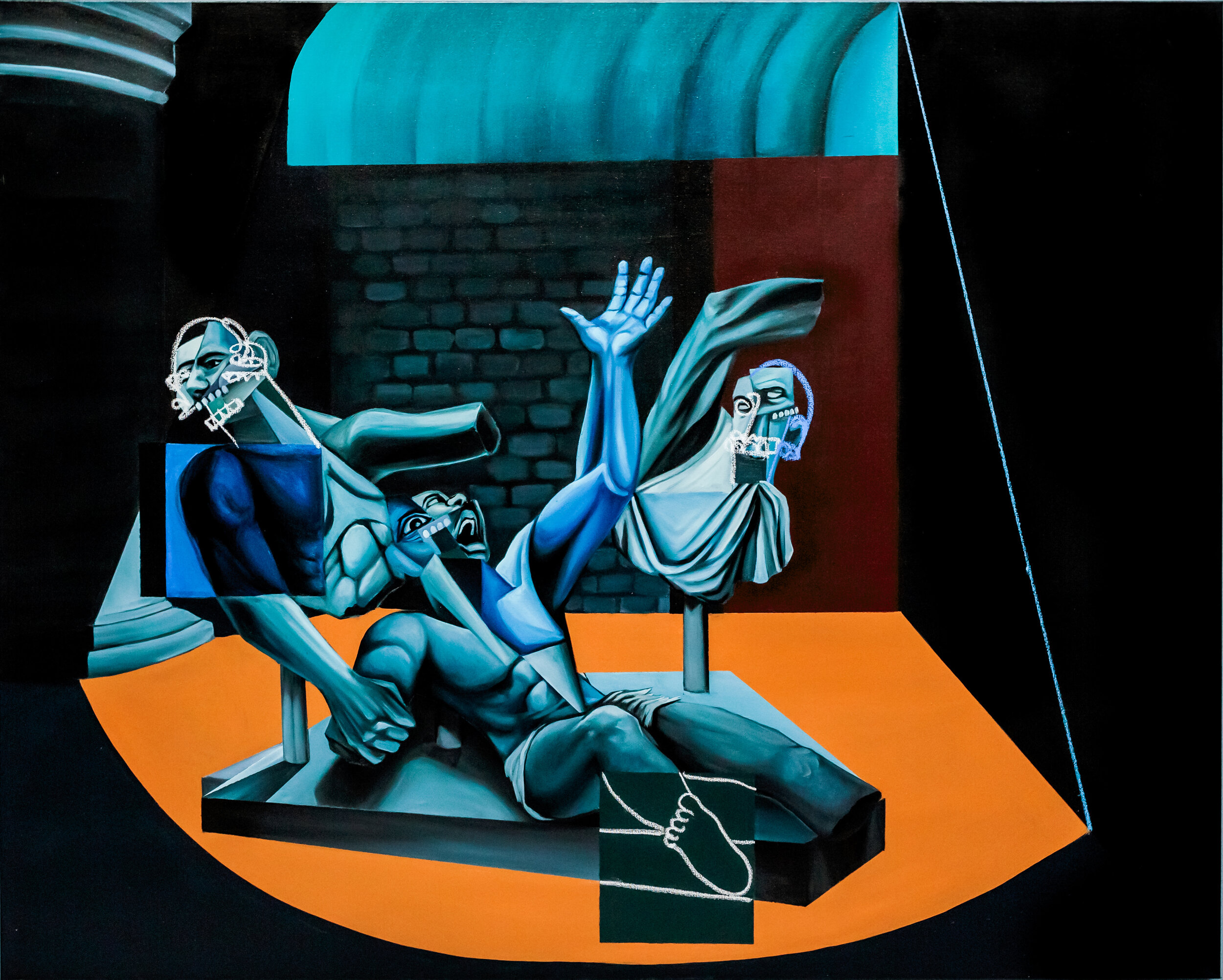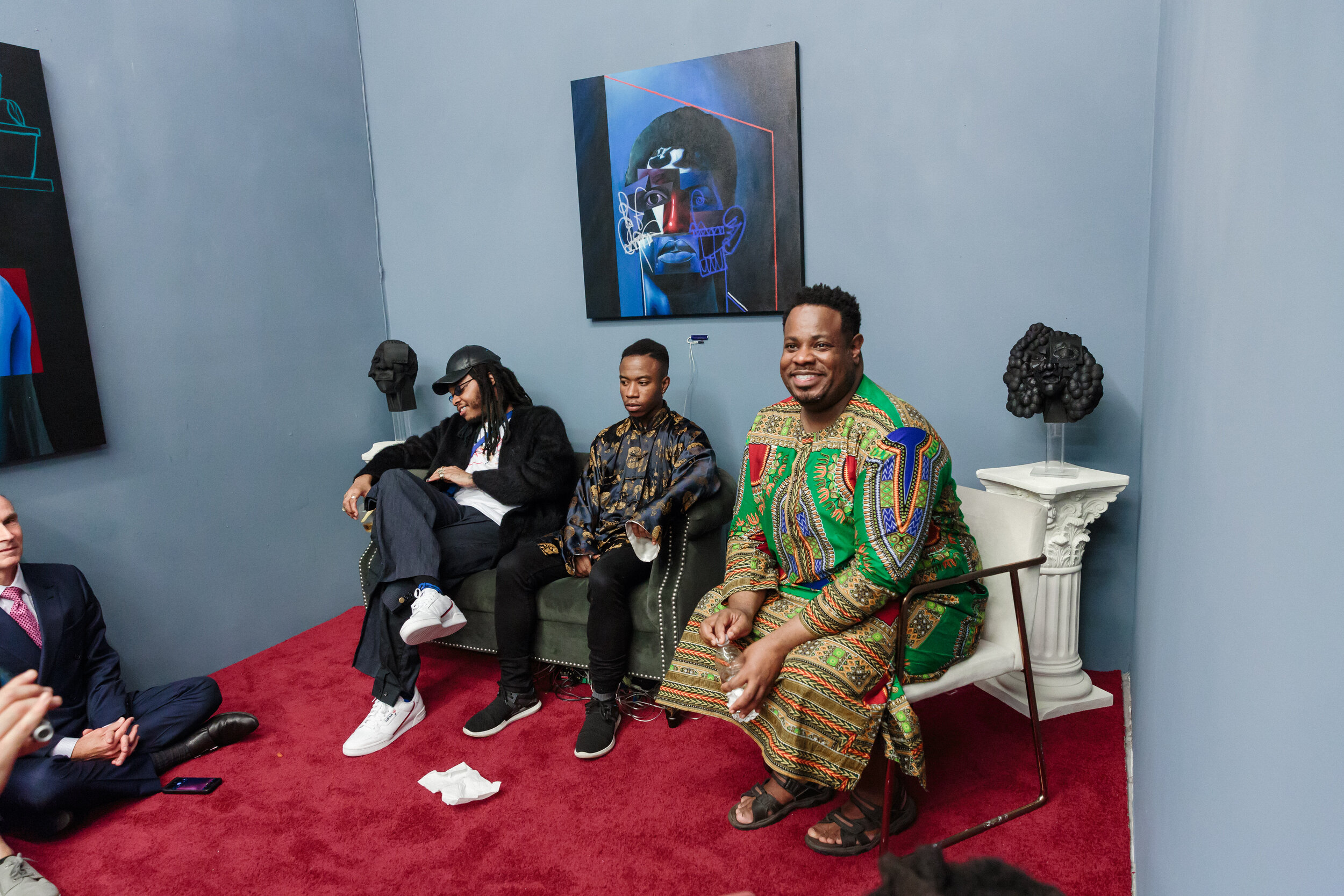BLK & BLUE
SOLO EXHIBITION BY MALIK ROBERTS
PRESS RELEASE
ABXY presents:
BLK & BLUE | Solo Exhibition by MALIK ROBERTS
OPENING COCKTAIL: THURSDAY SEPTEMBER 27th, 2018 | 7PM-9PM
EXHIBITION ON VIEW: FRIDAY SEPTEMBER 28th, 2018 – SATURDAY DECEMBER 15, 2018
Location: ABXY LES | 9 Clinton Street | New York, NY 10002
@malik.roberts.art | @abxyles | abxy.co | Artsy
(NEW YORK, NY) On September 27th, ABXY will present Blk & Blue, an exhibition of paintings, sculpture, and creative new media by artist MALIK ROBERTS. Blk & Blue marks Roberts’ second solo exhibition with the gallery, following the artist’s 2017 show Stolen, which focused on the appropriation of black culture in contemporary media.
Blk & Blue explores the topic of mental illness in communities of color. Roberts’ work often spotlights contemporary social issues: by breaking down formal elements in his paintings, the artist creates compositions, which convey the complexities and tensions typically masked by his subjects’ physical appearance. Inspired by Picasso’s Blue Period, for this exhibition, Roberts represents the everyday misfortunes of the oppressed in a palette primarily composed of blues and grays. Like Picasso’s somber depictions of middle-class Spaniards upended by the Industrial Revolution, in this exhibition, Roberts ennobles his subjects while shining light on the societal conditions responsible for their hardship. In so doing, the artist presents a new, American iconography for a country ever-defined by color.
For Blk & Blue the artist will present equal numbers of portrait and landscape paintings, relating environment to four major mental health issues plaguing black and brown communities: PTSD, anxiety, depression and bipolar disorder. In furtherance of this concept, the artist will create an augmented reality component for each work in the show. By holding the gallery’s iPad up to one of Roberts’ paintings visitors will be able to observe the unseen. By scanning landscapes, visitors will see the artist’s interpretation of the untold histories, undrawn borders, and invisible shackles, which perpetuate institutional racism across America today. By hovering over Roberts’ portraits, his subject’s inner world begins to appear, revealing the detrimental effects such adverse environments can have on mental health.
Opening night, curator Frantz “JR” Juin will be recording live interviews with volunteers open to sharing their experience of the show in the artist’s studio (located behind the gallery). That evening, Roberts will also unveil an accompanying soundscape designed in collaboration with producer Ja1da, which features music inspired by the works in Blk and Blue. Each work in the exhibition, corresponds to a song on the album. To hear exhibition soundtrack, please find the album on Spotify here.
ARTIST’S STATEMENT
“For this show, I wanted to focus on the topic of mental illness in communities of color. It’s an ongoing conversation that started a few years ago and has been getting a bit more notoriety lately. But I find the conversation that’s being had is often about the stigma associated with the topic rather than the sources. I’m more interested in looking at the sources.
The environmental factors that cause and perpetuate mental illness effect black and brown communities at a disproportionate rate to white communities. Every day, black people in America face conditions like food deserts, banking deserts, limited access to health care….the results of redlining, the criminalization of certain drugs, and the racism embedded in the criminal justice system. Environments that cause illnesses like anxiety, depression, PTSD, and bipolar disorder – these are our landscapes.
In my last show at ABXY [Stolen] I used more celebrities and icons as subjects because I felt that it made the subject matter more relatable. With Blk & Blue I chose to explore another topical conversation; but the subjects in this show are not the subjects you see in the news…They aren’t specific individuals or incidents either. They are ideas of people and situations that I’ve seen over and over throughout my life.
There’s a scene of a kid stealing food from a market because he can’t eat. Another of someone getting jumped in front of a corner store. A worried mother. A young fellow who’s seen some things Another young man, a bit older, who’s seen a little bit more, he’s more hardened. I wanted to memorialize these archetypes you might see in a black neighborhood. That’s why I made the portraits so statuesque. At the same time, I want my subjects to tell their stories through their eyes and faces.
With the landscapes, I want to convey the regularity of these scenes in black life and spotlight the trauma they inflict. That’s why, in many of these pieces, there’s only one light source and a lot of darkness. I spent time looking at Caravaggio’s work. I also studied Picasso, of course. Plus Goya, Van Dyke, and Bacon for this show. And a lot of Moorish paintings. Renaissance and Baroque art don’t include many black people. But Moorish art gives some perspective on what a black person might look like around the same time.
I believe in art as a mechanism for political change. It’s always been a driving force. I think about Obama’s campaign poster, Picasso’s Guernica, or Rosie the Riveter. Art has forged political revolution and cultural evolution all over the world for hundreds, if not thousands of years. That’s inspiring to me. My work often touches on social issues that have affected me or the people in my community. This show is no different. What I see is the point of me painting.”
- Malik Roberts, 2018
EXHIBITION ESSAY
by Daniel Dunson
IF THE WORDS black and blue are reversed, the phrase blue-black is activated. It is a pejorative phrase, a “throwback” that would have been used in the Black American community during the 1970s, 80s, and 90s. It is an inbred slur, born from internalized conditionings of colorism, the system rooted in racism that divided(s) people of color by privileging one hue over another, stereotypically categorizing and segmenting intelligence levels, personality traits, and labor divisions based on skin tone. “Boy you so black, you blue!” It means that the saturation of one’s melanin is so intense that it has created a blue cast on what would usually, or in this context, preferably be, brown skin. It means that you are the darkest of the dark, the blackest of the black, the most remote from whiteness. It implies that your genealogical line can most likely be traced directly to West Africa without any interruption of white ancestry. And with this blue-black designation, you have the least to be happy about, the most difficult life ahead, deserving of the most discrimination and oppression, and you are the bottom of the bottom.
The word blue, once isolated, has its own significance to the African Diaspora. Blue as in the Atlantic waters that brought captured Africans to the New World. Blue as in the crops of indigo that enslaved ancestors cultivated. Blue as in the bruising of skin suffering from the lash, the boot, the fist, the rope. Blue as in the eye color that you were never meant to have. Blue as the streetlight, the blues hall, the neon liquor store light, the blue velvet that appeared as funeral home curtains, and the lapis blue of stained glass church windows. Black and blue are inextricably linked to members of the black community; and long before the terms “depression”, or “mental illness” were used, one simply had “The Blues”. In this new series of painting, Blk & Blue, Malik Roberts makes no attempt to separate the murky feeling that these colors evoke. However, he has created a scale, variances of light and dark that highlights mental health within the black community and the people who far too often suffer in silence.
artist Malik Roberts, progress shot, ABXY Gallery 2018, photo courtesy Erik Bardin Photography
Born in Brooklyn, New York in 1990, Malik Roberts was not formally trained in a traditional, academic sense, but the education he received from familial and community-based learning perhaps serves him greater. He accredits his rigorous training and development to his father and uncle, both artistically gifted and discriminating teachers for the artist as an adolescent. “My uncle put me through something like a training camp. I would stay with him in the summer; he had stacks of Playboy, and Complex magazines. By the time he would come home from work, I would have had to finish several drawings from the magazines for him to look at. He was very hands on and didn’t let me get away with anything that was just average,” Roberts recalls. Under the scrutiny of his family teachers, young Malik learned the importance of critiquing his own work, pushing both his technical and conceptual abilities. “My uncle would point out small things like an ear and make me draw it over and over again until it was right. I think I painted about six paintings before my father ever told me that my work was any good,” says Roberts.
For three years, Roberts cut his teeth professionally working as an assistant to acclaimed artist Domingo Zapata. While with Zapata, Roberts’ painterly hand developed as he dealt with the accuracy and vigor of professional level painting. Though Roberts’ personal style deviates from the neo-expressionistic work of Zapata, he acknowledges the impression his former boss’s work ethic and teachings made on his current practice. “Domingo taught me that an unfinished line is sometimes stronger than a finished line; sometimes the emotion of what you put in a painting is a lot stronger than the technicalities,” explains Roberts.
Malik Roberts, Tuesdays on the Avenue, 2018
In Blk & Blue, Roberts makes a stylistic shift from past work that dealt with themes rendered with pop like expressionistic movement to the draftsmanship associated with academic master paintings. This move required the artist to engage with classicism within the cannon of Western art. The series combines Greco-Roman melodrama, renaissance and baroque theatrical staging, fragmented flat spaces of cubism, and the dreamlike environments of surrealism, to create a feeling of monumentality. “I just wanted to shine light on certain people. When you create a sculpture or a building, you are making something that other people have to take notice of, they have to look at it. So, the sculpture and architecture I used in this series blew up the issues, and the people dealing with these issues.”
The visual narratives of this series are drawn from the artist’s newly developed style that engages with classical tropes to highlight specific lived situations within the black community. In works like Blue for Many Reasons (2018), Roberts elevates quotidian objects such as hair bonnets and doo rags to iconographic story telling tools in contemporary portraits. These mundane drugstore items are charged with the cultural, and societal importance of keeping up physical appearances, despite internalized conflicts and trauma.
Roberts attempts to shed light on the environmental causes of certain behaviors, behaviors that often lead to a person being dismissed, devalued and ultimately dehumanized. The artist recognizes that many people in his community are masking their pain through their outward expressions of wholeness. “I think the black community suppresses mental health issues because we like to think that everything is going to be alright, we put on a smile, a church hat, and we present ourselves as being strong. Because for a long time we had to be strong because of the shit we went through—the shit we continue to go through,” he explains. “Its historical! It goes way back, we’ve always just had to take it, or we would die. It’s a survival tactic, but on the inside, we are dying.”
Malik Roberts, Blue for Many Reasons, 2018
Roberts’ paintings serve as a kind of document highlighting internal sufferings and elevating them to the surface. This series cracks the smiling facades that Roberts observes, and gives us an entrance into relatable circumstances that cause us to examine our own mental stability and fragility. Fragmented portraits, and deconstructed images appear as classical busts of marble, cracked, propped up, and like the art of antiquity, still surviving. In the work Tuesdays on the Avenue(2018), Roberts situates us inside a contemporary scene that is reminiscent of a Greek tragedy. The figures appear as theatrically blocked sculptures, dramatically gesturing in anguish, while their faces appear as distorted masks in dialog with cubist works of Picasso. Waterfalls, and topographical peaks and valleys depicted throughout the series create a sense of place while outlining depths and heights that disrupt the visual ease of navigation, causing us to diagnostically study the portraits and scenes. Brick walls, and columns integrate the classical past with contemporary urban landscape and architecture. Roberts has overlaid graffiti like motifs that appear skeletal, along with autopsy like diagrams that act to expose root causes of depression, anxiety, bipolar disorder, and posttraumatic stress disorder (PTSD).
Roberts felt the need to address the topics of Blk & Blue after dealing with bouts of depression through his youth and most recently after his last show. Feeling depleted, like he had poured all his talents into past works, Roberts was forced to examine himself, regroup and acknowledge that issues of mental health needed to be brought to the fore by depicting people of his own community. For this new work, Roberts researched mental illnesses that have been proven to be based on environmental causes. With societal causes in mind, Roberts has created environments that approach the situations of his subjects through surrealist interpretations. This move blurs the lines of reality and perception, and collapses barriers between the viewer and the painting.
Roberts created this series in the wake of pain and trauma that has recently become more outwardly expressed, and publicly discussed within communities of color. In this contemporary moment, Blk & Blue seeks to demonstrate the resilience and beauty of the black community and further the conversations that lead to coping and healing. The works are laden with personal and symbolic meaning, that speak to the artist’s community, family and to his inner self. Ultimately this series is a love letter written with the bruising of black and blue, but nonetheless, a love letter.
(left to right) artist Malik Roberts, producer J1da, and writer Daniel Dunson, ABXY Gallery, 2018
